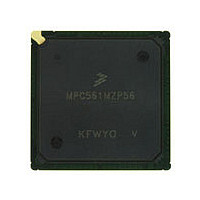MPC561MZP56 Freescale, MPC561MZP56 Datasheet - Page 580

MPC561MZP56
Manufacturer Part Number
MPC561MZP56
Description
Manufacturer
Freescale
Datasheet
1.MPC561MZP56.pdf
(1420 pages)
Specifications of MPC561MZP56
Cpu Family
MPC56x
Device Core
PowerPC
Device Core Size
32b
Frequency (max)
56MHz
Interface Type
QSPI/SCI/SPI/UART
Total Internal Ram Size
32KB
# I/os (max)
56
Number Of Timers - General Purpose
22
Operating Supply Voltage (typ)
2.6/5V
Operating Supply Voltage (max)
2.7/5.25V
Operating Supply Voltage (min)
2.5/4.75V
On-chip Adc
2(32-chx10-bit)
Instruction Set Architecture
RISC
Operating Temp Range
-40C to 125C
Operating Temperature Classification
Automotive
Mounting
Surface Mount
Pin Count
388
Package Type
BGA
Program Memory Type
ROMLess
Program Memory Size
Not Required
Lead Free Status / RoHS Status
Not Compliant
Available stocks
Company
Part Number
Manufacturer
Quantity
Price
Company:
Part Number:
MPC561MZP56
Manufacturer:
Freescale Semiconductor
Quantity:
10 000
Company:
Part Number:
MPC561MZP56R2
Manufacturer:
Freescale Semiconductor
Quantity:
10 000
- Current page: 580 of 1420
- Download datasheet (11Mb)
QADC64E Enhanced Mode Operation
Resolution begins with the most significant bit (MSB) and works down to the least significant bit (LSB).
The switching sequence is controlled by the comparator and successive-approximation register (SAR)
logic.
14.3.15 Comparator
The comparator is used during the approximation process to sense whether the digitally selected
arrangement of the DAC array produces a voltage level higher or lower than the sampled input. The
comparator output feeds into the SAR which accumulates the A/D conversion result sequentially,
beginning with the MSB.
14.3.16 Bias
The bias circuit is controlled by the STOP signal to power-up and power-down all the analog circuits.
14.3.17 Successive Approximation Register
The input of the successive approximation register (SAR) is connected to the comparator output. The SAR
sequentially receives the conversion value one bit at a time, starting with the MSB. After accumulating the
10 bits of the conversion result, the SAR data is transferred to the appropriate result location, where it may
be read from the IMB3 by user software.
14.3.18 State Machine
The state machine receives the QCLK, RST, STOP, IST, CHAN[6:0], and START CONV signals, from
which it generates all timing to perform an A/D conversion. The start conversion signal (START CONV)
indicates to the A/D converter that the desired channel has been sent to the multiplexor. IST indicates the
desired sample time. The end of conversion (EOC) signal notifies the queue control logic that a result is
available for storage in the result RAM.
14.4
The digital control subsystem includes the control logic to sequence the conversion activity, the clock and
periodic/interval timer, control and status registers, the conversion command word table RAM, and the
result word table RAM.
The central element for control of the QADC64E conversions is the 64-entry CCW table. Each CCW
specifies the conversion of one input channel. Depending on the application, one or two queues can be
established in the CCW table. A queue is a scan sequence of one or more input channels. By using a pause
mechanism, sub queues can be created in the two queues. Each queue can be operated using one of several
different scan modes. The scan modes for queue 1 and queue 2 are programmed in QACR1 and QACR2
(control registers 1 and 2). Once a queue has been started by a trigger event (any of the ways to cause the
QADC64E to begin executing the CCWs in a queue or sub-queue), the QADC64E performs a sequence
of conversions and places the results in the result word table.
14-38
•
Sample Capacitor — The sample capacitor is employed to sample and hold the voltage to be
converted.
Digital Subsystem
MPC561/MPC563 Reference Manual, Rev. 1.2
Freescale Semiconductor
Related parts for MPC561MZP56
Image
Part Number
Description
Manufacturer
Datasheet
Request
R

Part Number:
Description:
MPC5 1K0 5%
Manufacturer:
TE Connectivity
Datasheet:

Part Number:
Description:
MPC5 500R 5%
Manufacturer:
TE Connectivity
Datasheet:

Part Number:
Description:
MPC5 5K0 5%
Manufacturer:
Tyco Electronics
Datasheet:

Part Number:
Description:
MPC5 5R0 5%
Manufacturer:
Tyco Electronics
Datasheet:

Part Number:
Description:
MPC5 50K 5%
Manufacturer:
Tyco Electronics
Datasheet:

Part Number:
Description:
MPC5 1R0 5%
Manufacturer:
Tyco Electronics
Datasheet:

Part Number:
Description:
TOWER ELEVATOR BOARDS HARDWARE
Manufacturer:
Freescale Semiconductor
Datasheet:

Part Number:
Description:
TOWER SERIAL I/O HARDWARE
Manufacturer:
Freescale Semiconductor
Datasheet:

Part Number:
Description:
LCD MODULE FOR TWR SYSTEM
Manufacturer:
Freescale Semiconductor
Datasheet:

Part Number:
Description:
DAUGHTER LCD WVGA I.MX51
Manufacturer:
Freescale Semiconductor
Datasheet:

Part Number:
Description:
TOWER SYSTEM BOARD MPC5125
Manufacturer:
Freescale Semiconductor
Datasheet:












